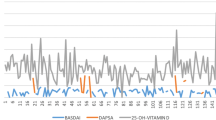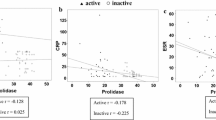Abstract
In the recent years, the role of melatonin (MLT) in the pathogenesis of inflammatory arthritis has been investigated, and the serum levels of MLT have been evaluated, but clinical study concerning MLT and ankylosing spondylitis (AS) is little reported in literature. We aimed to investigate the serum levels of MLT and their relation with the disease activity parameters of patients with AS. Forty AS patients and 40 healthy controls (matched for age and sex with the patients) participated in this study. Demographic and clinical data were collected and assessed. Disease activity of AS patients was assessed clinically according to the Bath AS Disease Activity Index (BASDAI), while AS functional impairment was assessed using the Bath AS Functional Index (BASFI). Serum samples were collected from all subjects to evaluate serum MLT, ESR, and CRP. Serum MLT levels were significantly increased in AS patients as compared to healthy controls (95% CI: 4.63, 8.77, P < 0.001). ESR and CRP are significantly higher in the AS patients compared with the controls (P < 0.001). AS patients with active disease had significantly higher ESR (P = 0.0151), CRP (P = 0.0124), and BASFI (P = 0.0016). Also, the MLT serum level in AS patients with BASDAI ≥40 was 39.7 ± 6.2 pg/ml compared with 35.2 ± 3.5 pg/ml in AS patients with BASDAI <40 (95% CI: 1.22, 7.78, P = 0.0106). Also, serum MLT level was significantly higher in the AS patients with enthesopathy than those without enthesopathy. Serum MLT levels were correlated with the duration of morning stiffness, BASDAI, BASFI, and CRP but not with ESR or duration of the disease. Serum levels of MLT were significantly increased in AS patients as compared to healthy controls. MLT levels correlated positively with BASDAI, BASFI, duration of morning stiffness, and CRP levels. Thus, it seems that MLT levels reflect the disease activity in AS patients.

Similar content being viewed by others
References
Karakoc M, Altindag O, Keles H, Soran N, Selek S (2007) Serum oxidative-antioxidative status in patients with ankylosing spondylitis. Rheumatol Int 27(12):1131–1134
Srinivasan V, Spence DW, Trakh I, Pandi-Perumal SR, Cardinali DP, Maestroni GJ (2008) Immunomodulation by melatonin: its significance for seasonally occurring diseases. Neuroimmunomodulation 15:93–101
Maldonado MD, Murillo-Cabezas F, Terron MP, Flores LJ, Tan DX, Manchester LC, Reiter RJ (2007) The potential of melatonin in reducing morbidity-mortality after craniocerebral trauma. J Pineal Res 42:1–11
Agez L, Laurent V, Guerrero HY, Pévet P, Masson-Pévet M, Gauer F (2009) Endogenous melatonin provides an effective circadian message to both the suprachiasmatic nuclei and the pars tuberalis of the rat. J Pineal Res 46(1):95–105
Rosen J, Than NN, Koch D, Poeggeler B, Laatsch H, Hardeland R (2006) Interactions of melatonin and its metabolites with the ABTS cation radical: extension of the radical scavenger cascade and formation of a novel class of oxidation products, C2-substituted 3-indolinones. J Pineal Res 41:374–381
Tan DX, Manchester LC, Terron MP, Flores LJ, Reiter RJ (2007) One molecule, many derivatives: a never-ending interaction of melatonin with reactive oxygen and nitrogen species? J. Pineal Res 42:28–42
Tomas-Zapico C, Coto-Montes A (2005) A proposed mechanism to explain the stimulatory effect of melatonin on antioxidative enzymes. J Pineal Res 39:99–104
Pieri C, Marra M, Moroni F, Recchioni R, Marcheselli F (1994) Melatonin: a peroxyl free radical scavenger more effective than vitamin E. Life Sci 55:271–276
Reiter RJ, Tan DX, Manchester LC, Tamura H (2007) Melatonin defeats neurally-derived free radicals and reduces the associated neuromorphological and neurobehavioral damage. J Physiol Pharmacol 58(Suppl 6):5–22
Martin M, Macias M, Escames G, Leon J, Acuna-Castroviejo D (2000) Melatonin but not vitamins C and E maintains glutathione homeostasis in t-butyl hydroperoxide-induced mitochondrial oxidative stress. FASEB J 14:1677–1679
Cutolo M, Seriolo B, Craviotto C, Pizzorni C, Sulli A (2003) Circadian rhythms in RA. Ann Rheum Dis 62:593–596
Cutolo M, Maestroni GJM (2005) The melatonin-cytokine connection in rheumatoid arthritis. Ann Rheum Dis 64:1109–1111
Kalpakcioglu B, Senel K (2009) The role of melatonin in rheumatic diseases. Infect Disord Drug Targets 9(4):453–456
van der Linden S, Valkenburg HA, Cats A (1984) Evaluation of diagnostic criteria for ankylosing spondylitis. A proposal for modification of the New York criteria. Arthritis Rheum 27(4):361–368
Garrett S, Jenkinson T, Kennedy LG, Whitelock H, Gaisford P, Calin A (1994) A new approach to defining disease status in ankylosing spondylitis: the Bath Ankylosing Spondylitis Disease Activity Index. J Rheumatol 21(12):2286–2291
Calin A, Garrett S, Whitelock H, Kennedy LG, O’Hea J, Mallorie P et al (1994) A new approach to defining functional ability in ankylosing spondylitis: the development of the Bath Ankylosing Spondylitis Functional Index. J Rheumatol 21:2281–2285
Senel K, Baykal T, Melikoglu MA, Erdal A, Karatay S, Karakoc A, Ugur M (2009) Serum melatonin levels in ankylosing spondilitis: correlation with disease activity. Rheumatol Int. Epub 2009 Oct 24. doi:10.1007/s00296-009-1223-x
Cutolo M, Maestroni GJ, Otsa K, Aakre O, Villaggio B, Capellino S et al (2005) Circadian melatonin and cortisol levels in rheumatoid arthritis patients in winter time: a north and south Europe comparison. Ann Rheum Dis 64:212–216
Maestroni GJ, Cardinali DP, Esquifino AI, Pandi-Perumal SR (2005) Does melatonin play a disease-promoting role in rheumatoid arthritis? J Neuroimmunol 158:106–111
Yu HS, Tsin ATC, Reiter RJ (1993) MLT: history, biosynthesis, and assay methodology. In: Yu HS, Reiter RJ (eds) MLT. Biosynthesis, physiological effects, and clinical applications. CRC Press, Boca Raton, pp 1–17
Cutolo M, Masi AT (2005) Circadian rhythms and arthritis. Rheum Dis Clin North Am 31:115–129
Straub RH, Cutolo M (2001) Involvement of the hypothalamic–pituitary–adrenal/gonadal axis and the peripheral nervous system in rheumatoid arthritis: viewpoint based on a systemic pathogenetic role. Arthritis Rheum 44:493–507
Cutolo M (2009) Night-time glucocorticoid–a paradigm shift in glucocorticoid therapy in rheumatoid arthritis? Eur Musculoskelet Rev 4(2):41–43
Author information
Authors and Affiliations
Corresponding author
Rights and permissions
About this article
Cite this article
Senna, M.K., Olama, S.M. & El-Arman, M. Serum melatonin level in ankylosing spondylitis: is it increased in active disease?. Rheumatol Int 32, 3429–3433 (2012). https://doi.org/10.1007/s00296-011-2197-z
Received:
Accepted:
Published:
Issue Date:
DOI: https://doi.org/10.1007/s00296-011-2197-z




